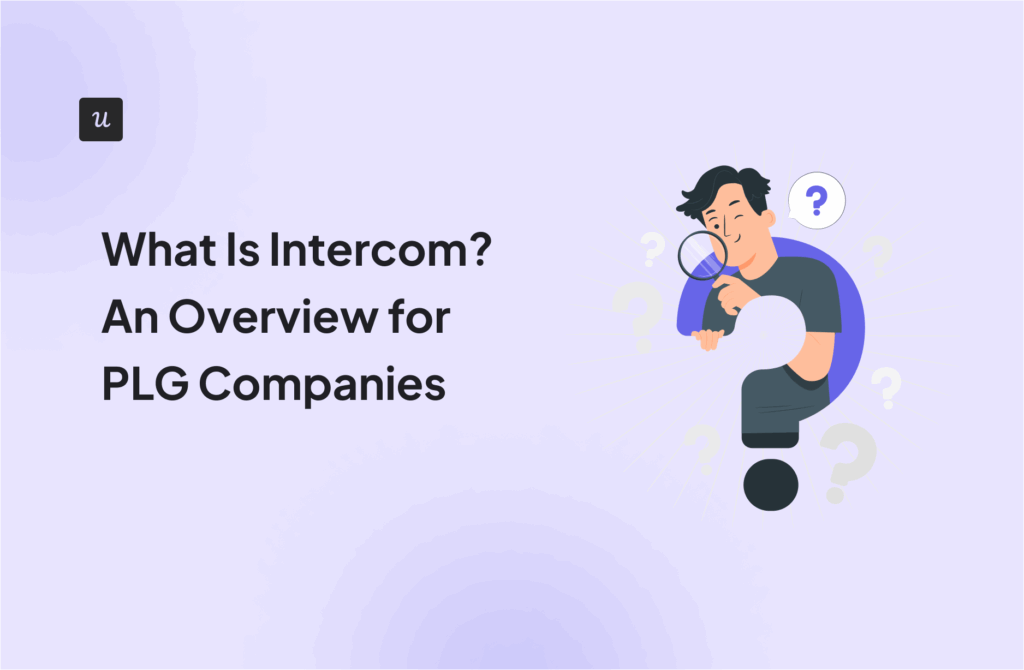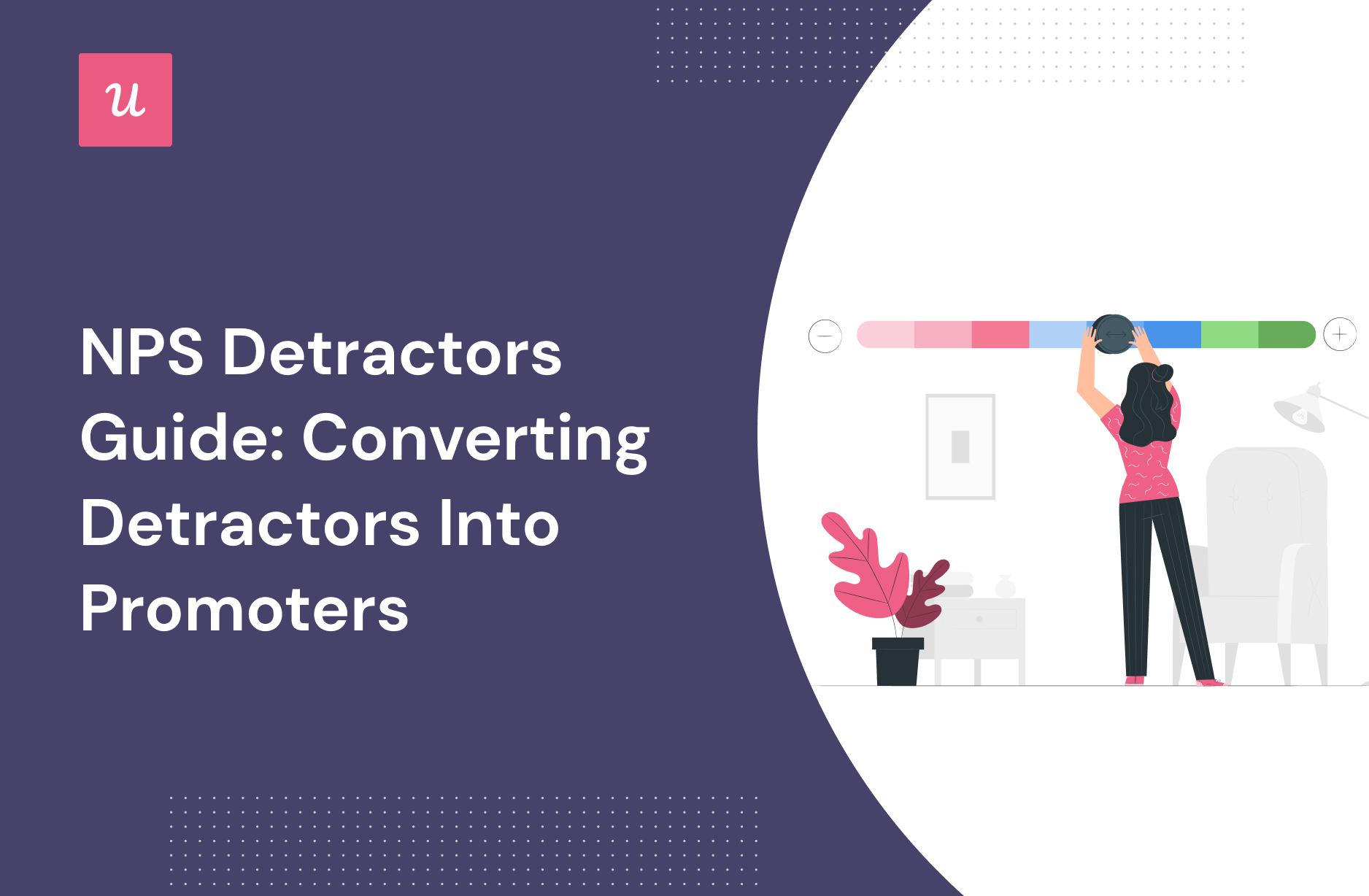
How well do you know your NPS detractors?
If the answer is “Not well” or “Who?” then read on to find out how this potentially scary customer segment actually holds incredible value for your business.
Even if you’ve got a good handle on user sentiment with your product, harnessing it to transform negativity into positivity can be challenging.
That’s why we’re here to help with a step-by-step guide for identifying, analyzing, and converting detractors into promoters.
Let’s jump right in!
Try Userpilot Now
See Why 1,000+ Teams Choose Userpilot

What are NPS detractors?
Detractors can be defined as those who are encountering friction in using your product and service.
Using a net promoter score (NPS) survey, you ask customers to rate how likely they are to recommend your product to a friend/colleague on a scale from 0 to 10.
Customers who answer 6 or lower are your detractors, a low score being an indication that they are not happy using your product and won’t recommend you.
Hurtful as this feedback may feel, it’s important to remember that detractors are not your enemy – they just aren’t getting enough value from your product.
What is promoter vs detractor in NPS?
On the opposite, the narrower end of the NPS scale is the promoters. These are existing customers who respond with a 9 or 10 on an NPS survey.
In other words, promoters are a segment of survey respondents who are so satisfied with your product and company that they’ll happily give a glowing recommendation when the opportunity arises.
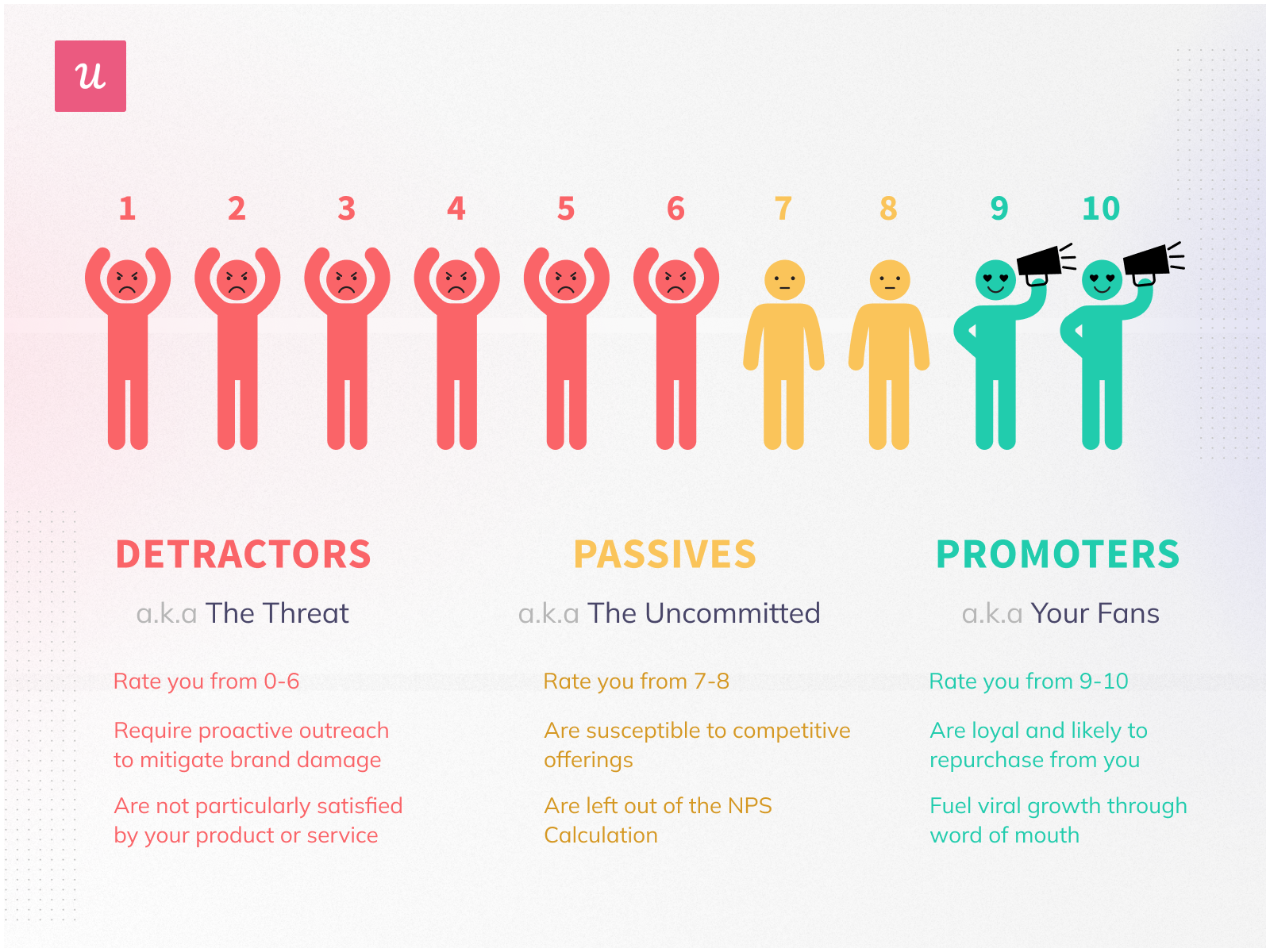
How to identify detractors?
NPS detractors are extremely unhappy customers that are most noticeable when you discover them among reviews of your product online.
But this isn’t the best way to go about identifying them.
Instead, use customer satisfaction surveys proactively to tease out your promoters, passives (customers who you give a 7-8 score), and detractors.
NPS is the most common type of microsurvey for discovering detractors and valuable insights into what turned them into dissatisfied customers. It segments your customers directly into the three categories, based on the NPS scores they answer in your survey.
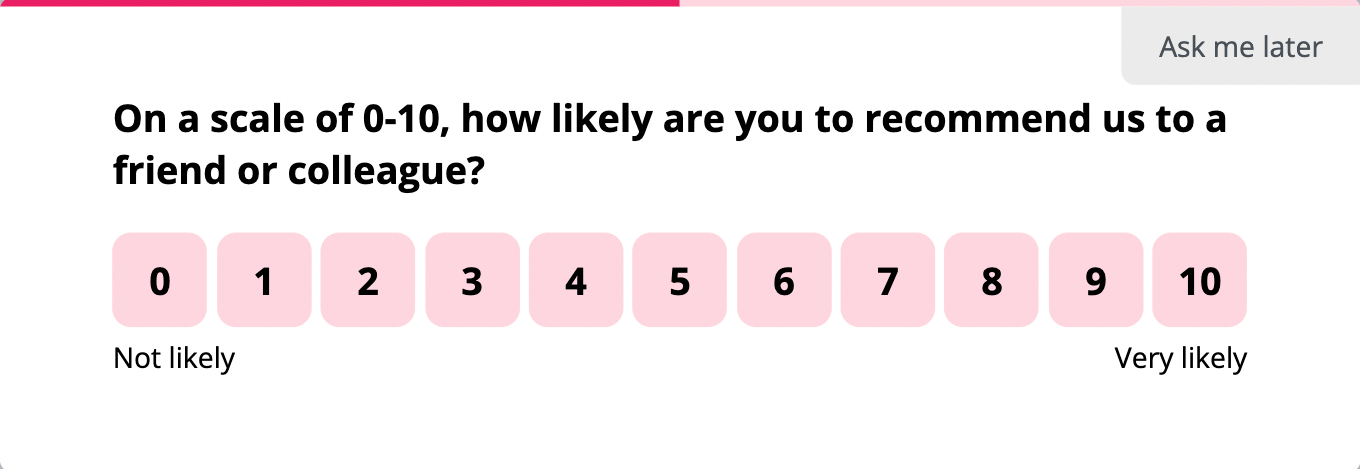
The NPS scores are an indication of customer loyalty. However, Customer Satisfaction Score (CSAT) and Customer Effort Score (CES) surveys are also useful indicators.
While the latter two scores may not tell you directly who the detractors are, you can bet that customers who give a low rating on CSAT aren’t pleased with your product or service. Likewise, low CES results show you customers who are struggling to make effective use of your product.
Continuously collecting customer feedback through a net promoter system allows you to identify customers that are having issues along the customer journey. You must address these concerns before they churn due to poor customer experience.
Why do you need to turn NPS detractors into promoters?
For successful companies, the importance of customer experience and satisfaction doesn’t end at the point of purchase. Satisfied customers are the ones most likely to stick with your product month over month.
As a result, a large pool of NPS detractors is basically a landslide of churn and negative reviews waiting to happen. For retaining existing customers, it’s crucial to encourage feedback and address issues that create detractors.
Doing so lets you convert unsatisfied customers and increase customer loyalty.
Identify detractors to reduce churn
Churn is when a customer stops using your product (i.e., unsubscribes from your SaaS).
There are a number of reasons why churn occurs, but the most prominent is that the customer isn’t receiving enough value from your product.
That may sound familiar because it’s effectively the definition of a detractor. Unhappy customers give low NPS scores because they experience friction and poor value from your product.
This puts them at high risk of churn, and churn equals revenue loss in the business world.
Reducing churn rate should be a high priority for any SaaS business. To this end, implementing a system to find detractors and address their concerns in a continuous way is a key tool for fighting churn. You can do this by using customer surveys (we’ll cover this in a bit).
Find detractors to reduce negative word of mouth and create loyal customers
Online reviews have tremendous power to sway people toward or away from purchasing your product.
It takes 40 positive customer experiences to counteract the harm of one negative feedback. And the picture gets even worse when considering that 38% of customers would only do business with a company with a 4-star rating.
In short, bad word of mouth hurts your brand and keeps people from trying your product.
You’re not entirely at the mercy of reviewers, though. Taking negative feedback seriously will help you improve your product and inform outreach to turn NPS detractors into promoters, thus preventing negative feedback and reviews before they hit the web.
Turn detractors into promoters and increase revenue
You can turn the detractor’s vicious cycle into a virtuous one if you start viewing negative feedback as advice for improvement.
When you act on negative feedback received from your detractors, your product and customer service improve, and your customers slide closer to the promoter side of the NPS scale.
This is critical for your business because more promoters mean a more positive word-of-mouth recommendation.
And if the increase in promoters is due to product improvements, then the new customers that your promoters refer to will start out with a great experience that puts them closer to being promoters themselves.
All this results in overall higher user retention rates and increased revenue for your company.
Types of detractors: Not all unhappy customers fit in the same category
While there are many possible reasons that a customer isn’t experiencing enough value from your product, most detractors fit into one of the following four categories (hint: not all detractors are bad).
Understanding which kind of detractors you’re dealing with helps when strategizing about how to reach them.
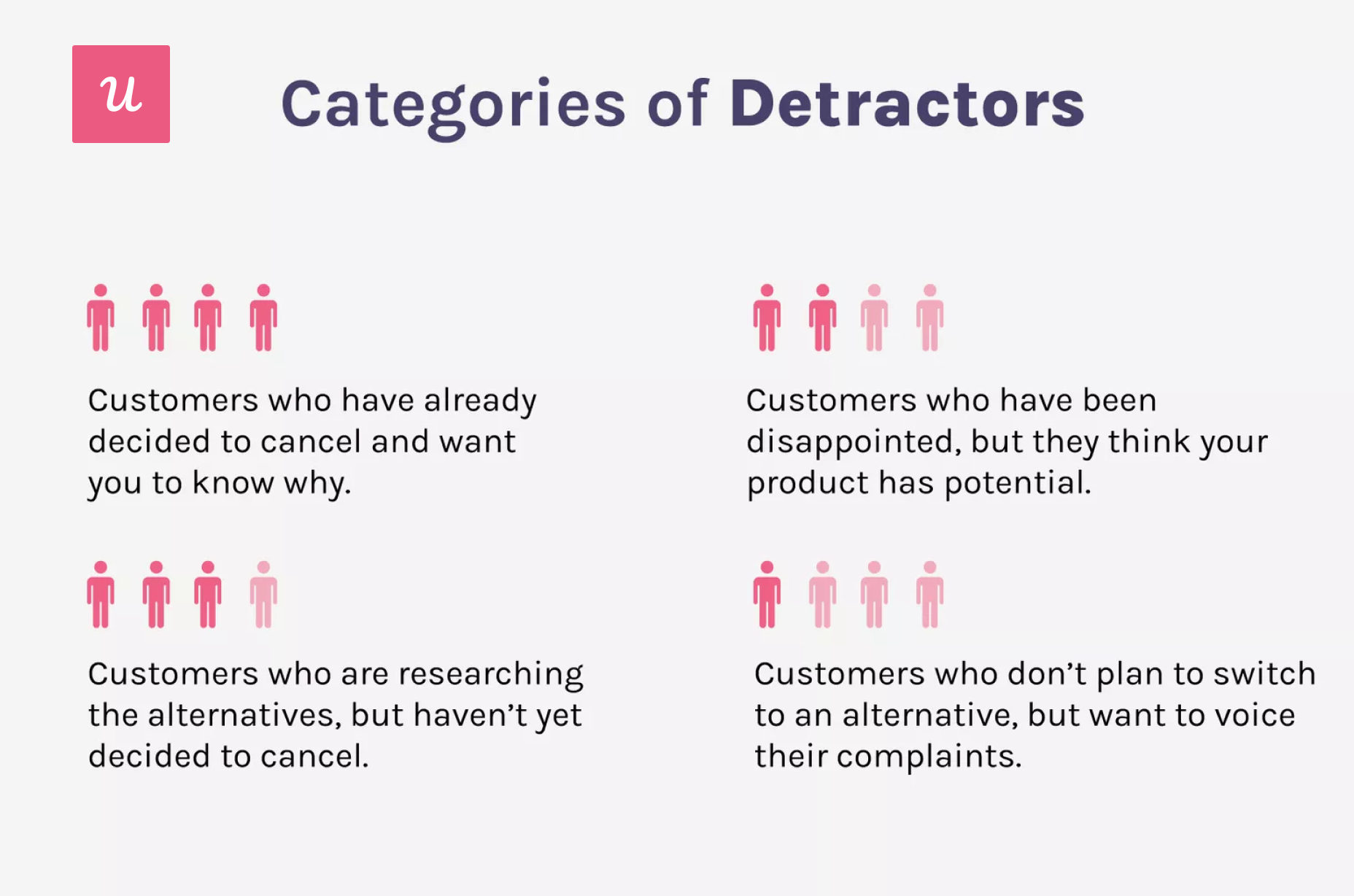
The departing
These are unhappy customers who have decided to stop using your product and are on their way out.
They may still be subscribed for now, but they’re at the highest risk of churning in the shortest amount of time. Valuable feedback from this group will be about why they’re canceling.
The fence-sitters
This group comprises customers who are actively looking for alternatives to your product but haven’t made the decision to cancel yet.
They are also at a high churn risk, but you have an opportunity to communicate with them and try to resolve issues inducing them to churn.
Get feedback from these customers about what factors are causing them to seek value elsewhere.
The disgruntled
Disgruntled customers see value in your product but face a poor customer experience.
They may not be an immediate risk for churn, but if their issues remain unresolved then you’ll probably see them leave eventually.
Disgruntled customers are a good source of feedback about where value can be added or enhanced in your product.
The loyal but disappointed
Customers in this final group have no plans to leave your product but have complaints that they want you to hear. Listening to these customers and closing the feedback loop by addressing their concerns will go a long way toward preventing a slide into the other categories of detractors.
How to turn NPS detractors into promoters using feedback?
Naturally, you’d like all of your customers to be promoters.
Promoters don’t churn, they generate referrals, and they’re generally great contributors to your brand and finances. So how can you turn unfavorable feedback into insights and improve the customer’s perception into a positive impression?
To help, we’ve put together strategies to get you on your way to converting detractors into NPS promoters and using automated responses that allow you to close the feedback loop faster and improve customer experience.
Ask a follow-up question in your Net Promoter Score surveys
NPS score surveys help you find detractors, but the rating by itself doesn’t tell you anything about why the customer is a detractor.
To get that information you’ll need to ask a follow-up question once the customer has completed an NPS survey. An open-ended question that asks users to explain his/her answer will give you the most useful information.
Getting this qualitative data and understanding how users feel is critical because the difference between a 0, 3, or 6 on an NPS can indicate vastly different user experiences and issues. However, you’ll never know what those are unless you ask!
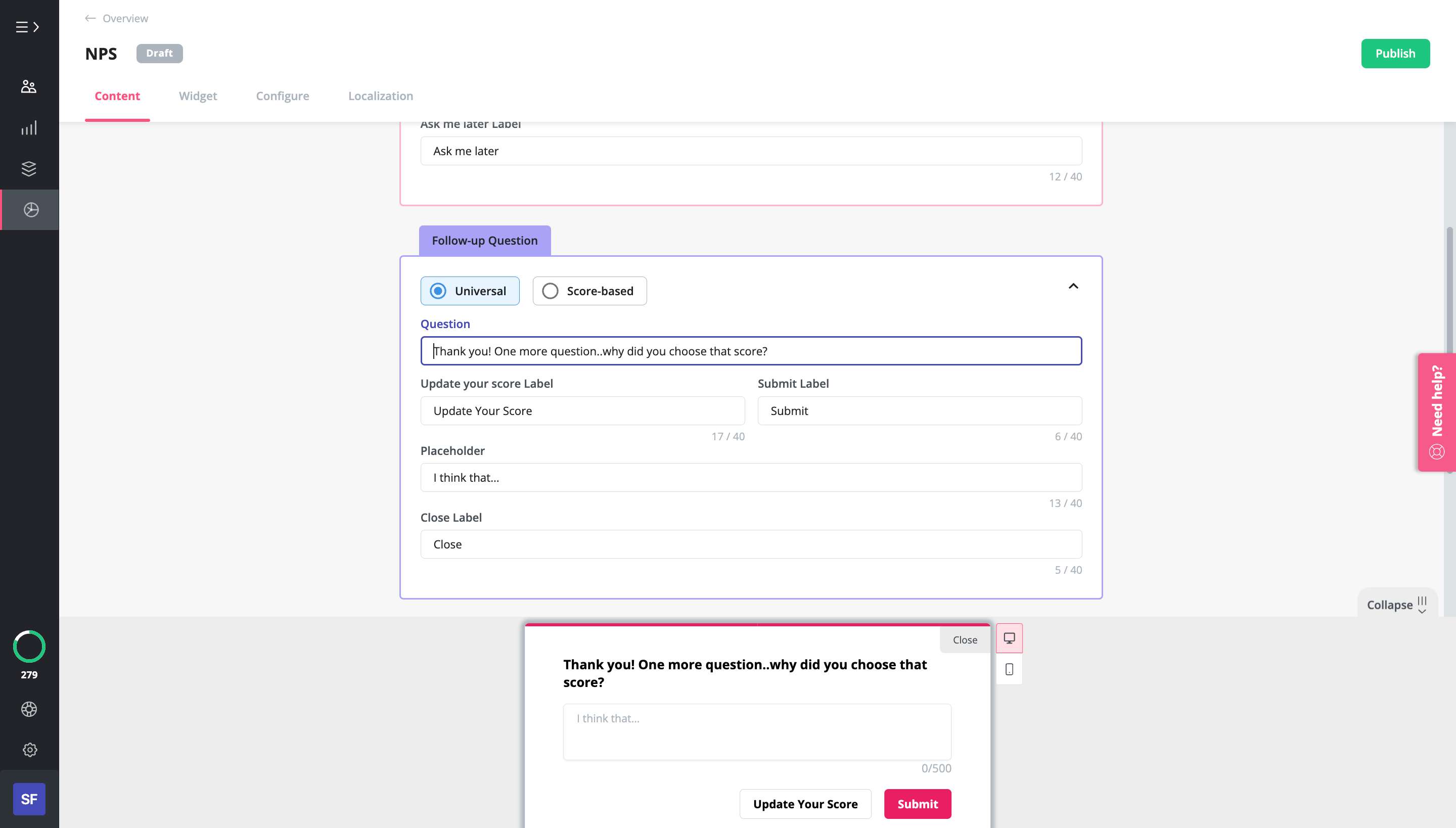
Analyze detractors’ NPS responses
Once you’ve collected NPS responses and follow-up question answers, it’s time to start analyzing the data.
Most tools will calculate the net promoter score automatically and point out the detractors for you. This gives you a good overview of your promoter-to-detractor ratio.

This overview can generate a good picture of your overall customer satisfaction, but the truly useful data is in the open-ended responses.
Reading and analyzing feedback from all your dissatisfied users can be time-consuming and even dispiriting. But remember: negative feedback from even one unhappy customer is a powerful resource for product improvement!
If you want to enhance customer value from your product and reduce churn, don’t skip out on qualitative feedback.
Luckily, with the right tools sifting through customers’ sentiments doesn’t have to be a chore.
With a tool like Userpilot, you can set up tags and group customer feedback responses by theme. Check out the example below.

In the example above, we can see that “customer support” led to -100 in the NPS score.
This makes it easy to see recurring themes in detractor feedback and understand the most common problems for survey respondents so you can prioritize resolving them.
Empathize with detractors and follow-up
Making unhappy customers feel heard is an important step toward them changing their feelings about your product.
However, venting frustrations to a robot doesn’t really count as being “heard.”
This doesn’t mean automated responses and self-service options are bad, just that in some cases, a human touch is required.
A recent study found that 79% of users want real human interaction in customer service. Knowing that a living, breathing human being has heard their concern and is working toward a solution can make a big difference for a customer on the fence about continuing to use your product.
You can use NPS analytics to discover customer detractors and offer personalized help. A personalized, empathetic response to customers’ feedback shows them that there’s a real person on the other end listening and working to solve their problem.

Automatically respond to detractors in-app and increase customer satisfaction
Reaching out personally to customers sends a clear message that their concerns are important to your company.
However, it isn’t the most scalable strategy once you get a large user base.
An alternative tactic is to respond to detractors automatically in-app. While this may seem like a return to the dreaded robo-service, effective use of NPS feedback software can make it a non-robotic interaction.
As we saw above, NPS survey software lets you segment customers by their survey responses. Once you’ve done this, you can create personalized in-app messages that trigger after customers complete the survey.
Depending on your needs, these segments can be broad or quite granular – you could create one segment for all detractors or multiple segments within each NPS score.

Offer in-app self-support to reduce the number of detractors
Some unsatisfied customers become detractors because they can’t access support when they need it.
For instance, a customer may find a bug in your product but doesn’t have the time, energy, or opportunity to report it. This could be because your support team is backlogged, or simply because the customers can’t be bothered to check your website for product documentation.
An effective remedy for such problems is in-app self-service support.
The main idea is to provide users with quick access to in-app help that doesn’t interrupt product use.
Some specific examples of how this is implemented in-app include knowledge base documentation, support contact links, and on-demand guidance for troubleshooting. Take a look at how this can be built with Userpilot:

Use churn surveys to learn and reduce detractors
Just because a customer churns doesn’t mean you’ve failed. Churn surveys that trigger when a customer cancels their subscription are a great way to learn what’s motivating detractors.
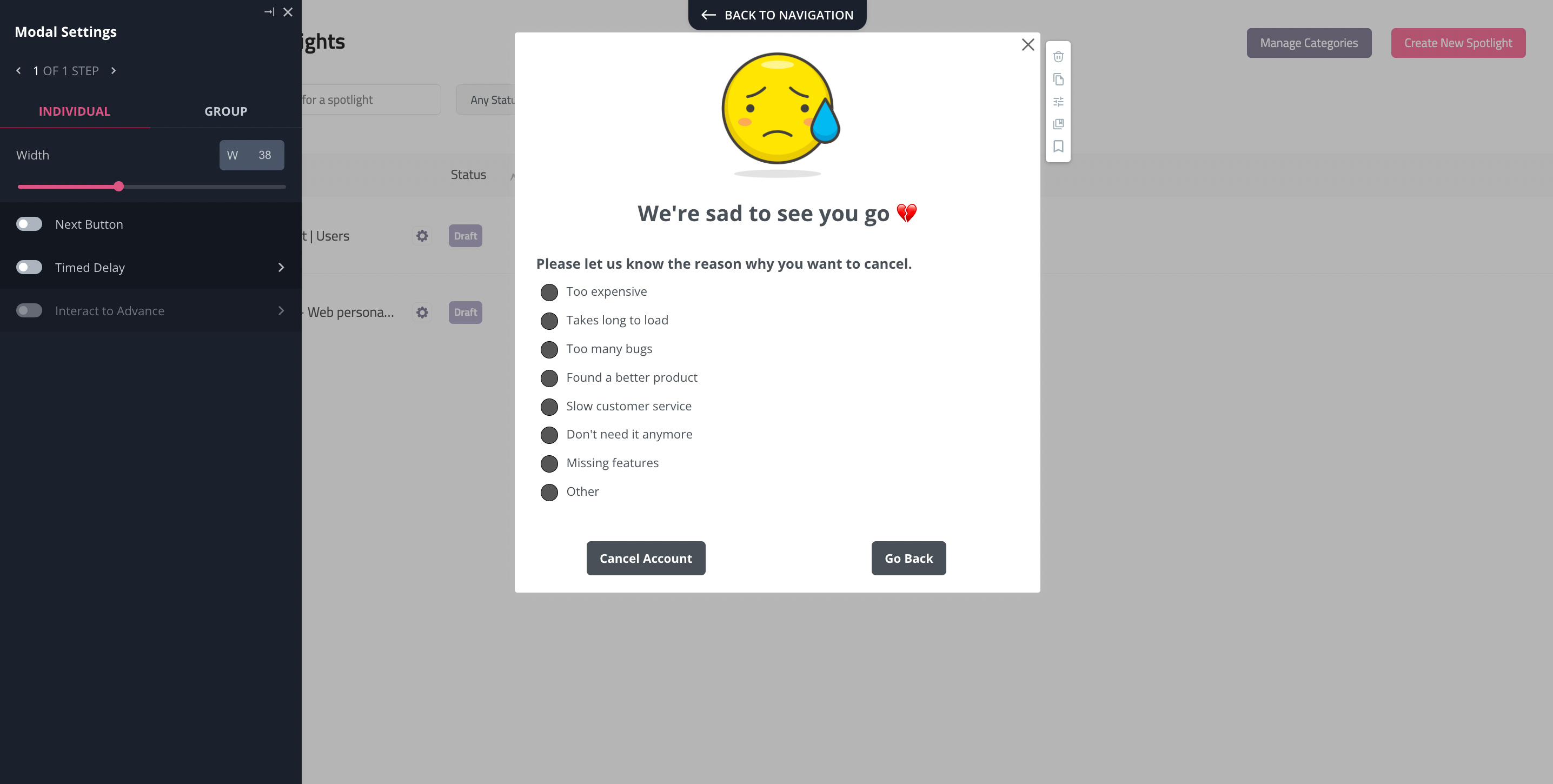
Look at churn surveys as an opportunity to identify unsatisfied customers and fill in the value gaps before more users fall through them. Understanding why they leave lets you improve your product for current and new customers.
Analyze promoters and use the learnings to educate detractors
Promoters are your model users.
It’s worthwhile to learn from them and discover how they became such satisfied users.
Product usage analytics can help you understand promoter behavior with your product and how their customer journey differs from the detractors. With this in mind, you can build in-app experiences and onboarding processes that educate customers on how to get better value from your product.
For example, is there a specific set of features that promoters tend to use? If so, build checklists that guide new users to discover and adopt these features as part of secondary onboarding.
To see this in action, check out our case study on how Kommunicate used checklists and in-app experiences to help customers discover important features.

Act on feedback received from detractors and close the loop
Responding empathetically to detractor feedback shows you care. But the goodwill dries up pretty fast if your efforts stop there.
Make sure you go the distance to resolve angry customers’ problems and concerns.
And once you’ve done so, don’t forget to let them know!
Even if it’s been months since the initial feedback, communicate with the customer to tell them about the improvements.
Closing the loop shows that not only do you listen to how users feel, but you take action to improve their experience.
This is also important when you’ve launched a new feature that many detractors requested. They can’t adopt the feature if they don’t know it exists, so spread the word!
You might even consider letting detractors pilot-test new features and get their feedback before launching to your entire customer base. This makes them feel special, plus they’re likely to have useful feedback on whether the new feature actually meets their needs or if it could be improved.

What to do when you have no feedback from detractors?
Regularly checking in on your customers via feedback is key to keeping satisfaction high.
But monitoring customer engagement is another important early warning signal for catching detractors before the churn.
Your customers’ engagement score is based on user journey analytics and it tells you how engaged or disengaged your users are.
In essence, it measures how many times your users interact or not with your product and its features at key milestones along their journey, and adds or subtracts points for action or inaction.
A low engagement score is a red flag.
In this case, it’s a good idea to reach out to this user segment to find out what’s stopping engagement and offer support.
You can also boost engagement by continuously testing in-app experiences to optimize the experience. Improving engagement like this is a proactive way to nudge detractors toward becoming promoters.
Is it possible to turn every detractor into a promoter?
Realistically, it is not possible to convert each and every detractor into a promoter. No matter how supportive you become and implement the feedback requested by detractors, customers leave, and there’s nothing you can do about that.
At the least, you can create a positive impression that you went above the mile to cater to unhappy customers and retain them. Sometimes a customer’s use case doesn’t match your business model, but leaving them with a good impression ensures they promote positive word of mouth regarding your customer support.
Who knows, they might use your product again if the situation arises.
The best tools for turning NPS detractors into promoters
As with any project, using the right tools for the job can make or break your success.
That’s why we’ve put together our top recommendations for tools that will best support you to start turning detractors into promoters.
Userpilot – for collecting, analyzing, and acting on feedback in-app

Userpilot is a top-of-the-line software for collecting feedback through NPS surveys and implementing the strategies we’ve covered in this article.
We’ve already introduced some of Userpilot’s features that will help you address detractors, but here’s a roundup of all the key functions Userpilot provides for boosting your promoter population (all without the need for any coding):
- NPS analytics automatically sorts your customer base into promoter, passive, and detractor categories.
- NPS response tagging lets you sort qualitative responses by keywords and analyze them for trends.
- Build in-app microsurveys that you can set to trigger on specific in-app events (for example, churn surveys when a customer cancels their subscription).
- The in-app survey widget makes it quick and easy to collect quantitative and qualitative data. Setting up surveys in-app makes it far more likely users will engage with them than if you send questions via email.
- Set up in-app self-serve support resources (such as knowledge bases).
- Trigger automatic, personalized in-app messages and experiences based on customers’ survey responses or other in-app behaviors.
- In-depth product analytics lets you see how customers use your product so that you can enhance onboarding experiences.
And those are just the most relevant features for turning detractors into promoters using feedback. To check out all this and more, book a Userpilot demo today.
Fullstory – for analyzing qualitative data
Maybe you want to get a really detailed understanding of how customers are using your website. After all, customer usage patterns can offer powerful insight into what may be causing them to lean toward promoting or detracting.
In that case, Fullstory offers in-depth session recording and product analytics tools.
Track page views, clicks, and a host of other customer behaviors to see where friction might be causing customer dissatisfaction (or what features are pushing users toward conversion).
Fullstory’s AI and machine learning are also there to help you make sense of data. For a good look at your customers’ qualitative web experience, this tool has you covered.
Heap – for in-depth product usage analytics
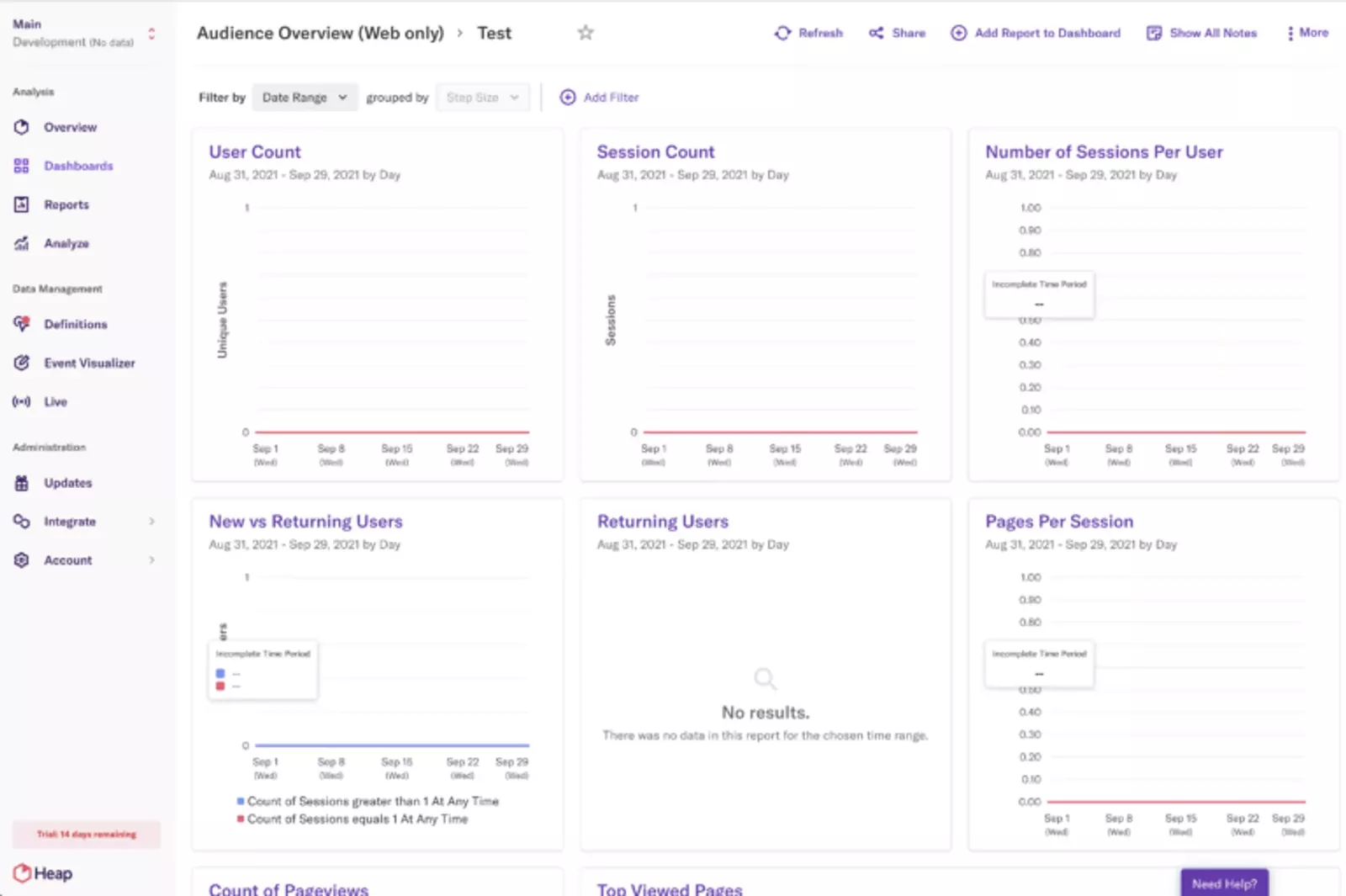
Another great option for product analytics is Heap. Heap tracks everything users do in-app and generates in-depth reports on how exactly customers are using your product.
You can also use this data to segment and track specific customer cohorts, and then use Heap’s detailed analytics to get a full, clear picture of how customers interact with your product.
If you’re looking to really drill down into the granular analytics of product usage, Heap’s tools have everything you need.
Conclusion
Detractors harm and create serious problems for your company, but they’re also an amazing resource for product improvement and growth if handled effectively.
So instead of feeling threatened by customers who aren’t satisfied with your product, positively interact with them. Acting on detractor feedback will reduce your churn and make a huge difference in your success metrics.
But just as important, it’ll also tip some of them toward promoting, which brings higher revenue, better user retention, and fewer unsatisfied customers.
In short, don’t treat your NPS results like a conclusive judgment about your product. Instead, use them as part of your customer experience program that leads to higher customer satisfaction.
Are you ready to start converting your NPS detractors into promoters? Grab a Userpilot demo to get started today!






